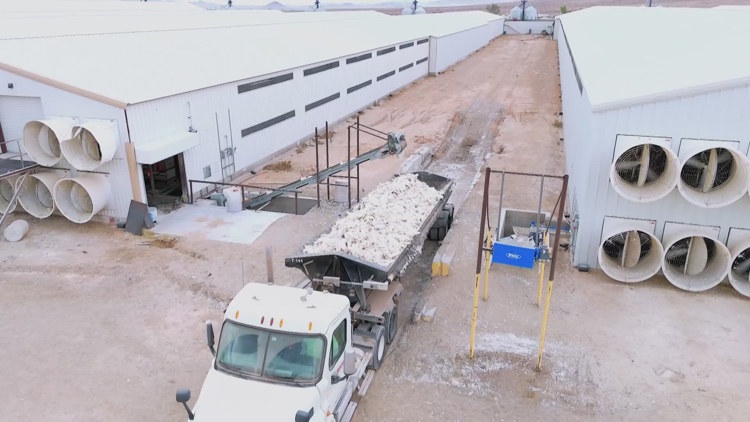Neighbors concerned about groundwater after millions of
chickens were buried on Arizona farm; environmental studies underway
Amid contamination concerns expressed by neighbors and activists, the state issued a waiver allowing Hickman’s to bury more than 2 million chickens at its property.

KHOU11
Author: Joe Dana
Published: 9:38 PM CDT June 19, 2025
Updated: 10:31 AM CDT June 21, 2025
PHOENIX — State leaders charged with overseeing waterways and farms are publicly discussing for the first time the massive bird flu outbreak that hit Hickman’s Family Farms last month.
Amid contamination concerns expressed by neighbors and activists, Arizona Department of Environmental Quality Director Karen Peters said the state issued a waiver allowing Hickman’s to bury more than 2 million chickens at its Tonopah property.
“We have issued to Hickman’s with their approval and cooperation, what we call a temporary emergency waiver that will assess the hydrology and geology of the area where the burial occurred, so that we can be certain that the groundwater is protected,” Peters said.
Peters said there “is no current risk to the aquifer at the burial site,” but acknowledged the results of the
hydrology and geology tests need to be completed.
“Once we have all that information, we can work with them on a plan to make sure that that remains the case,” Peters said.
Department of Agriculture Deputy Director Sheldon Jones said several agencies have been working around the clock for the past month to
oversee cleanup and containment of the outbreak, which led to 6 million chicken deaths at three Hickman’s industrial farms.
“They have been working 24/7 through holidays to manage this in the most expedient, efficient, public health, environmental way possible,” Jones said.
A spokesperson for the Fair Agriculture Council – a nonprofit that investigates labor and animal conditions at industrial farms – said the decision to bury millions of chickens where impact studies were not previously conducted reveals lax regulations.
“I would be very concerned that no research has been done to determine whether this kind
of disposal method in this particular place is safe,” said JC Berger. “In many cases, contamination travels through the groundwater. It leeches through the soil, travels through surface waters.”
Berger alleges agencies that regulate industrial farms like Hickman’s are too cozy with the industry.
EPA regulations
require large farms to create a mortality disposal plan, warning that burials “can result in groundwater contamination.”
To what extent Hickman’s had a plan in place is not known. Peters and Jones said they had not seen a plan but they said Hickman’s developed a biosecurity plan last year after a different outbreak.
During an interview with 12News last week, Hickman’s CEO Glenn Hickman said they dug 12-foot deep trenches and buried 4 million chickens in them. Asked about potential contamination of water tables, Hickman
said, “There’s always going to be concerns.”
“But we have septic systems and cemeteries all over this country, and in this state. So I don't know that just the fact that we're burying a lot of them at one time makes a big difference,” Hickman said.
Peters said the state used emergency funds to help Hickman’s with
landfilling millions of chickens at a cost of up to $1.5 million.
“Because that operation was so immense and we needed it to be done very quickly, we stepped in to provide funding and contractors to get it done,” Peters said. “USDA does authorize on-site burial as a disposal method, but in Arizona, our state laws require that we be more protective of groundwater, and so we stepped in and provided
assistance so that the landfilling could occur, and we provided the material and hauling to do that.”
Tonopah resident Dan Blackson obtained Hickman’s Nutrient Management Plan from the Department of Environmental Quality in 2015. That document shows that Hickman’s stated it would bury carcasses off-site. It also states that in the event of an emergency mortality event, the company would work closely with the
USDA for guidance. There are no other details provided regarding preparations for mass diposals.
Jones defended the way state agencies and Hickman’s have responded to the outbreak.
“Decontamination, disinfection, all of those operations are underway in Tonopah,” Jones said. “But to suggest we have a plan for
every incident at every corner, is a pretty tall ask on something of this magnitude.”